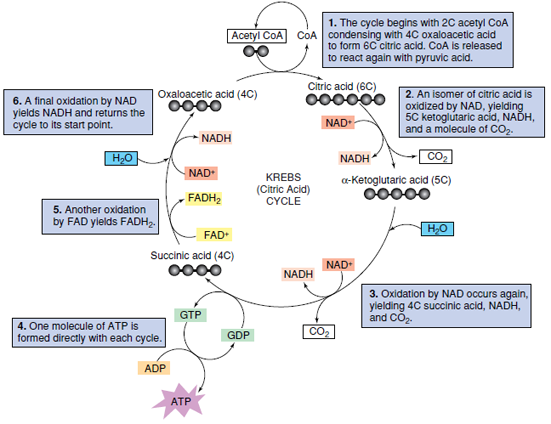Krebs Cycle: Oxidation of Acetyl Coenzyme A
Krebs Cycle: Oxidation of
Acetyl Coenzyme A
Degradation (oxidation) of the 2-carbon acetyl group of acetyl coenzyme A occurs in a cyclic sequence called the Krebs cycle (also called citric acid cycle and tricarboxylic acid cycle [TCA cycle]) (Figure 4-13). Acetyl coenzyme A condenses with a 4-carbon acid (oxaloacetic acid), releasing coenzyme A to react again with pyruvic acid. Through a series of reactions the two carbons from the acetyl group are released as carbon dioxide, and oxaloacetic acid is regenerated. Hydrogen ions and electrons in the oxidations transfer to NAD and to FAD (flavine adenine dinucleotide, another electron acceptor), and a pyrophosphate bond is generated in the form of guanosine triphosphate (GTP). This high-energy phosphate readily transfers to ADP to form ATP. The overall products of the Krebs cycle are CO2, ATP, NADH, and FADH2:

The molecules of NADH and FADH2 formed will yield 11 molecules of ATP when oxidized in the electron transport chain. The other molecules in the cycle behave as intermediate reactants and products which are continuously regenerated as the cycle turns.
Degradation (oxidation) of the 2-carbon acetyl group of acetyl coenzyme A occurs in a cyclic sequence called the Krebs cycle (also called citric acid cycle and tricarboxylic acid cycle [TCA cycle]) (Figure 4-13). Acetyl coenzyme A condenses with a 4-carbon acid (oxaloacetic acid), releasing coenzyme A to react again with pyruvic acid. Through a series of reactions the two carbons from the acetyl group are released as carbon dioxide, and oxaloacetic acid is regenerated. Hydrogen ions and electrons in the oxidations transfer to NAD and to FAD (flavine adenine dinucleotide, another electron acceptor), and a pyrophosphate bond is generated in the form of guanosine triphosphate (GTP). This high-energy phosphate readily transfers to ADP to form ATP. The overall products of the Krebs cycle are CO2, ATP, NADH, and FADH2:
The molecules of NADH and FADH2 formed will yield 11 molecules of ATP when oxidized in the electron transport chain. The other molecules in the cycle behave as intermediate reactants and products which are continuously regenerated as the cycle turns.
 |
| Figure 4-13 Krebs cycle in outline form, showing the production of three molecules of reduced NAD, one molecule of reduced FAD, one molecule of ATP, and two molecules of carbon dioxide. The molecules of NADH and FADH2 will yield 11 molecules of ATP when oxidized in the electron transport system. |




